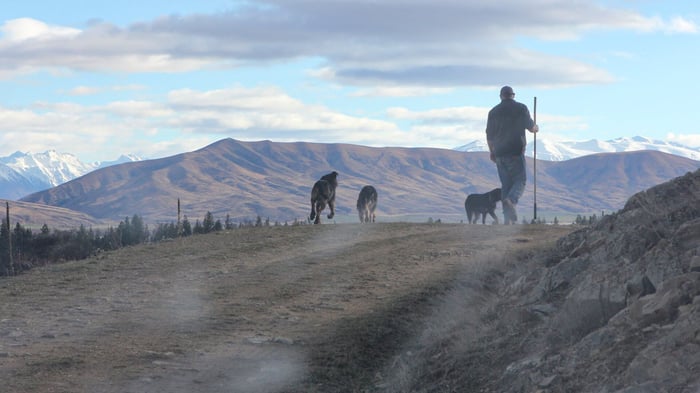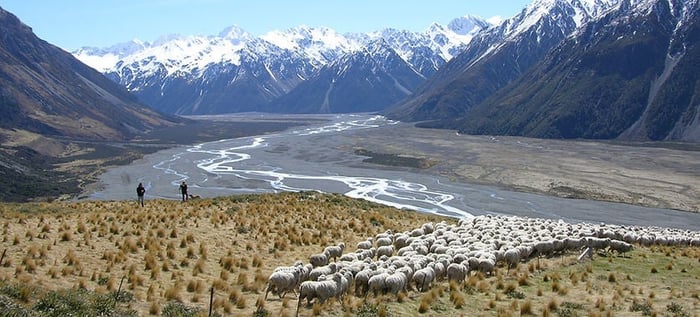Table of Contents
Shrink Your Carbon Footprint Through Supporting Regenerative Farming
Learn the benefits, practical steps, and how supporting local farmers and communities can help promote a healthier planet.
Introduction
Reducing your carbon footprint is crucial in the fight against climate change. One impactful way to do this is through regenerative farming. This sustainable agricultural method not only helps restore ecosystems but also significantly reduces carbon emissions. In this article, you'll learn how regenerative farming can help shrink your carbon footprint and contribute to a healthier planet.
What we often forget is that the choices we make at home ripple far beyond our front doors. Every bite of food, every blanket on our bed, every item we bring into our homes connects us to the land—and the people who tend it. Regenerative farming gives us a rare opportunity to turn that connection into something meaningful. It’s not just about carbon or soil—it’s about care.
When we support regenerative farmers, we’re backing people who are working with nature instead of against it. These farmers aren’t just producing food and fiber; they’re restoring habitats, protecting biodiversity, and passing on healthier soil to the next generation. It’s slow, thoughtful work. And it matters.
Organic Wool Comforter | Made in New Zealand, Breathable All-Season Comfort

$342.00
$380.00
Sleep naturally better with our organic wool comforter Unlike down or synthetic comforters that trap heat, our spun wool design wicks away moisture and prevents overheating, so you stay cool & dry. Designed for deeper sleep with a gentle weight… Read more
At Antipodean Home, we partner with low-impact regenerative wool farmers in New Zealand who embody this care. We’ve seen firsthand the difference it makes—to the land, to the animals, and to the communities involved. And when you bring that regenerative wool into your home, you're helping grow that positive impact.
Because the truth is, building a better future isn’t just a global issue—it’s a deeply personal one. And it can start with something as simple (and comforting) as where your bedding comes from.What is Regenerative Farming?
Regenerative farming is an approach to agriculture that focuses on restoring and enhancing the health of the soil. Unlike conventional farming, which often depletes soil nutrients, regenerative farming aims to rebuild organic matter and improve biodiversity. This method includes practices like cover cropping, no-till farming, and holistic grazing.
The practice of regenerative agriculture is generally guided by five core principles: minimizing soil disturbance (no-till farming), maximizing crop diversity, keeping the soil covered with cover crops, maintaining living roots year-round, and integrating livestock (holistic grazing). These practices work together to build a robust soil ecosystem that is more effective at capturing carbon and resisting drought.
 Image from NZ Merino Company
Image from NZ Merino CompanyThe Benefits of Regenerative Farming
1. Carbon Sequestration
One of the most significant benefits of regenerative farming is its ability to sequester carbon. Healthy soils act as carbon sinks, absorbing CO2 from the atmosphere and storing it underground. By adopting regenerative practices, you help increase the soil's capacity to capture and hold carbon.
2. Enhanced Soil Health
Regenerative farming enhances Soil Health by improving soil structure, increasing Water Retention, and boosting nutrient content. Healthier soils lead to more resilient crops, reducing the need for chemical fertilizers and pesticides, which are major sources of greenhouse gas emissions.
3. Biodiversity Boost
By promoting diverse planting and natural pest control methods, regenerative farming enhances biodiversity. A diverse ecosystem is more resilient to climate change and can better withstand extreme weather events.
4. Reduced Erosion and Water Runoff
Practices like cover cropping and no-till farming prevent soil erosion and reduce water runoff. This not only preserves soil integrity but also reduces the amount of carbon released into the atmosphere through soil disturbance.
 Image by NZ Merino Company
Image by NZ Merino CompanyHow Regenerative Farming Shrinks Your Carbon Footprint
1. Lower Emissions from Soil Management
Traditional farming practices often involve tilling, which releases stored carbon into the atmosphere. By minimizing tillage, regenerative farming reduces these emissions. Additionally, using organic fertilizers and compost instead of synthetic chemicals cuts down on fossil fuel use.
2. Efficient Water Use
Regenerative farming practices improve soil's water-holding capacity, leading to more efficient water use. This means less reliance on irrigation, which often involves significant energy use and contributes to carbon emissions.
3. Local Food Systems
Regenerative farming encourages the growth of local food systems, reducing the carbon footprint associated with transportation. By supporting local farms, you contribute to a decrease in food miles and the associated greenhouse gas emissions.
| Category | Regenerative Farming | Industrial / Intensive Farming |
|---|---|---|
| Core Philosophy | Works with nature to restore soil health, biodiversity, and carbon balance. | Exploits natural systems for maximum short-term yield and profit. |
| Soil Health | Builds living soil through composting, cover crops, and rotational grazing — increasing carbon storage and fertility. | Depletes soil with chemical fertilizers and monocropping, leading to erosion and loss of organic matter. |
| Carbon Footprint | Captures and stores atmospheric carbon through deep-rooted plants and healthy soil biology. | Emits large amounts of CO₂, CH₄, and N₂O from synthetic inputs, tilling, and livestock overconcentration. |
| Water Management | Improves water retention, filtration, and drought resistance through healthy soil and diverse root systems. | Causes runoff, water pollution, and dependency on irrigation due to degraded soil. |
| Biodiversity | Encourages plant, insect, and animal diversity — creating balanced ecosystems that self-regulate. | Destroys habitats and relies on pesticides and herbicides, which eliminate beneficial species. |
| Animal Welfare | Animals graze naturally and help fertilize and aerate soil — part of the ecosystem. | Animals are confined, often grain-fed, and treated as production units. |
| Fertilizer & Inputs | Uses compost, manure, and natural amendments to feed the soil life. | Depends on synthetic fertilizers and chemical pesticides. |
| Yield Over Time | Yields improve steadily as soil regenerates and becomes self-sustaining. | Yields may peak early but decline over time as soil health collapses. |
| Economic Model | Supports local, small-scale farmers with fair prices and long-term land resilience. | Centralized corporate control; profits extracted from land and farmers. |
| Climate Impact | Acts as a carbon sink — reducing greenhouse gases and increasing climate resilience. | Major source of global greenhouse gas emissions. |
| Long-Term Sustainability | Builds lasting fertility and environmental balance for future generations. | Unsustainable; dependent on fossil fuels, chemicals, and globalized supply chains. |
Steps You Can Take to Support Regenerative Farming
1. Educate Yourself and Others
Learn more about regenerative farming practices and their benefits. Share this knowledge with your community to raise awareness and support for sustainable agriculture.
2. Support Regenerative Farms
Buy products from farms that use regenerative practices. Look for certifications like Regenerative Organic Certified (ROC) to ensure you're supporting truly sustainable farms.
3. Support Your Local Farmers and Communities
Engage with and buy from your local farmers. Supporting local farmers not only reduces transportation emissions but also strengthens local economies and communities. Attend farmers' markets, join a local CSA (Community Supported Agriculture), and encourage others to do the same.
4. Advocate for Policy Change
Support policies that promote regenerative agriculture. Engage with local and national representatives to push for agricultural policies that prioritize sustainability and carbon reduction.
Why Regenerative Farming?
Regenerative farming is a game-changer for our planet's health. Traditional farming methods have long contributed to environmental issues like topsoil erosion, biodiversity loss, desertification, habitat destruction, and pollution. These practices have also significantly contributed to climate change, stemming from a longstanding misunderstanding of soil and ecosystem functions.
In contrast, regenerative farming aims not just to halt environmental degradation but to reverse it, all while producing our essential food, fiber, and fuel. Though there's no single definition, experts agree that its core is enhancing soil health by drawing carbon from the atmosphere back into the earth. This is achieved through various management practices that align with nature's systems.
At Antipodean Home, we're passionate about supporting regenerative farming. Our regenerative wool bedding is crafted from New Zealand merino wool sourced from farmers committed to low-impact, regenerative methods. By choosing our products, you're not just creating a cozy retreat; you're actively contributing to a healthier planet.
Regenerative Organic Cotton Sheet Set – Soft, Breathable & Sustainable

$189.00
Softer Sheets. Cleaner Sleep. Our organic cotton sheet set are simply better for the earth, and for your sleep. Grown on low-impact regenerative farms that actively heal the soil, our cotton is then woven and finished responsibly. This process eliminates… Read more
Conclusion
Regenerative farming offers a powerful solution for reducing your carbon footprint while promoting healthier ecosystems. By understanding and supporting regenerative practices, you can play a vital role in combating climate change and fostering a sustainable future. Start today by learning more, supporting regenerative farms, backing your local farmers and communities, and advocating for policy changes that prioritize the health of our planet.
By following these steps, you can help make a significant impact on reducing carbon emissions and promoting a more sustainable world.
Every purchase acts as a vote for the world you want to live in. By choosing products made with regenerative materials, like our New Zealand wool bedding, you are directly investing in farms that prioritize the planet's health over quick profits. This small, conscious choice transforms a simple piece of home comfort into a powerful statement of environmental support.
FAQs on Wool Duvet Inserts, Comforters & Sustainable Bedding
What is regenerative farming and how does it help reduce my carbon footprint?
Regenerative farming is an agricultural approach focused on restoring and enhancing soil health using practices like no-till farming and cover cropping. By improving soil health, it increases the ability of the soil to act as a carbon sink, absorbing CO2 from the atmosphere and storing it underground, which directly helps shrink your carbon footprint.
What are the main benefits of regenerative agriculture?
The main benefits include carbon sequestration (storing carbon in the soil), enhanced soil health (improving water retention and nutrient content), a biodiversity boost (creating resilient ecosystems), and reduced erosion and water runoff.
How can I support regenerative farms in my community?
You can support them by buying products from farms that use regenerative practices, looking for certifications like Regenerative Organic Certified (ROC), and supporting your local farmers by shopping at farmers' markets or joining a Community Supported Agriculture (CSA) program.
Does regenerative farming reduce the need for chemical fertilizers?
es. Because regenerative farming focuses on rebuilding organic matter and improving soil structure, it leads to healthier soils and more resilient crops, which reduces the need for chemical fertilizers and pesticides. This, in turn, cuts down on the fossil fuel use associated with synthetic chemical production, lowering emissions.
Why is supporting local food systems important for climate change?
Supporting local food systems that use regenerative practices reduces the carbon footprint associated with transportation. By decreasing "food miles," you contribute to a significant decrease in the greenhouse gas emissions caused by long-distance shipping.




